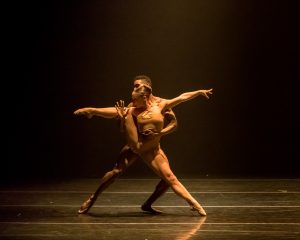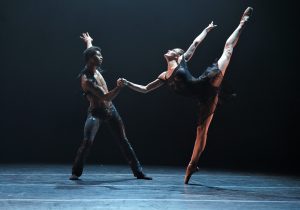
The “wow factor” when seeing a performance of Complexions Contemporary Ballet is incredibly high — in fact, it is off the charts.
During their one-night stand at the Kravis Center for the Performing Arts on April 2, the amazing New York-based ballet company checked off every box with aplomb — gorgeous dancers, a dazzling display of technical prowess, fantastic music and astonishing, non-stop choreography. The appeal was immediate and the audience was thrilled.
The show began with a bit of a glitch. The first work presented was not the work listed in the printed program. I was expecting to see Woke, which had a program note saying it was “a physical reaction to the daily news.” So, when Baroque music filled the theater and the company’s dancers took command of the stage, it took me a while to unscramble things and realize that it couldn’t be Woke that I was seeing. No problem — I could find out later —- I was completely riveted watching what was unfolding onstage.
The work presented was Bach 25, choreographed in 2018 by co-founder and co-director Dwight Rhoden to celebrate the company’s 25th anniversary. Rhoden chose to use various selections from his favorite composer of classical music, Johann Sebastian Bach (though there are also some selections from his son Carl Philipp Emanuel Bach) because he found Bach’s music so very danceable.
But Rhoden’s hybrid style of choreography, which draws inspiration from all kinds of dance forms, is distinctly different from any choreography one might expect to accompany these musical compositions written in the 18th century.
Glistening like a well-oiled machine, the mostly unison large ensemble formations in Bach 25 were formidable and danced with razor’s-edge clarity. Weaving crystal-clear steps and ballet lines together with movement from modern dance, jazz, improv and hip-hop, Rhoden created a repeating fabric of steps that was extremely effective.
As the sections broke into solos, duets and trios, the different dancers’ personalities blazed in
the ultra fast-paced choreography. At times, the driving energy of the work was hard to fully absorb and my eyes almost glazed over, but my sense of awe for these remarkable dancers never waned. The entire company was out there — dancing full throttle for the entire evening. The stamina alone was impressive.
The dancers’s chiseled physiques were highlighted by the revealing skin-toned costumes of costume designer Christine Darch and the rich sculpted lighting of lighting designer Michael Korsch. From super-tall to diminutive in stature, the 15 company dancers were wonderfully diverse in appearance but totally in sync in their movement and focus.

In the next work, Love Rocks (2020), Rhoden moved away from Baroque music to the rock of Lenny Kravitz. Set to nine songs by the Grammy award-winning artist, who is a personal friend of Rhoden, the work centered on the unifying theme of love. The dancers began in a tight circle facing inward before they erupted into an avalanche of tightly packed movement. It was a marvel to watch. How could they continue to look so brilliant — but so effortless — at the relentless clip of Rhoden’s choreography, especially now that the women were dancing on pointe?
The rock concert lighting and the sleek, black lamé costumes with their feathers and chiffon and a funk flair gave Love Rocks a different look from Bach 25, but Rhoden’s kinetic choreographic style prevailed. Rapid and wonderfully complex unison movement was framed by a multitude of running entrances and exits. However, there were moments — which were welcome —- where the tempo changed and things slowed down, as in the beautiful duet during the section set to “Calling All Angels.” The motif of a unified collective with its circle of love was revisited several times during the work including the final image.
It’s hard to separate what elements were responsible for the audiences’ zealous response. One might say that Rhoden’s choreography relies too heavy on the talent of the outstanding dancers, the highly relatable music, the dramatic lights and sexy costumes, but it is a formula that works. On that night, there was no doubt that the total package was entertaining and undeniably appealing, especially to audience members who might be less exposed to concert dance.
Looking around the theater, it was enormously refreshing to see an audience at a ballet performance that reflected the same diversity as the company. Without question, a new and young audience is desperately needed to replace the staid and aging audience that regularly attends ballet performances. Given the unfortunate hiatus that the performing arts has had to endure for the last two years, this is more true now than ever before.
As the audience exited, animated conversation bubbled over. It seemed as if the extraordinary energy of the dancers had somehow been infused into the audience. Their zealous reaction clearly showed that mixing it up in ballet really works. We must applaud Complexions Contemporary Ballet for their spectacular brand of ballet, which is successfully expanding dance audiences.